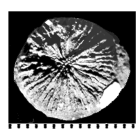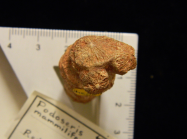Scleractinia taxon details
Podoseris Duncan, 1869 †
1371691 (urn:lsid:marinespecies.org:taxname:1371691)
accepted
Genus
Podoseris mammiliformis Duncan, 1869 † (type by subsequent designation)
- Species Podoseris affinis Duncan, 1889 †
- Species Podoseris anomala Duncan, 1889 †
- Species Podoseris brevis Duncan, 1889 †
- Species Podoseris dubia Duncan, 1889 †
- Species Podoseris elongata Duncan, 1869 †
- Species Podoseris jessoni Duncan, 1889 †
- Species Podoseris mammiliformis Duncan, 1869 †
marine, fresh, terrestrial
fossil only
Duncan PM. (1869). A monograph of the British fossil corals. Second Series, Part 2 (1): Corals from the White Chalk, the Upper Greensand, and the Red Chalk of Hunstanton. <em>Palaeontographical Society Monographs.</em> 22: 1-26, pls. 1-9. [details]
Status Recently, this taxon was revised, using original and type material of the Duncan, Tomes, and H. le Strange collections...
Status Recently, this taxon was revised, using original and type material of the Duncan, Tomes, and H. le Strange collections housed at the British Museum London. All specimens were collected from the type locality of the type species (Baron-Szabo, 2013). [details]
Hoeksema, B. W.; Cairns, S. (2024). World List of Scleractinia. Podoseris Duncan, 1869 †. Accessed at: https://www.marinespecies.org/scleractinia/aphia.php?p=taxdetails&id=1371691 on 2024-08-16
Date
action
by
original description
Duncan PM. (1869). A monograph of the British fossil corals. Second Series, Part 2 (1): Corals from the White Chalk, the Upper Greensand, and the Red Chalk of Hunstanton. <em>Palaeontographical Society Monographs.</em> 22: 1-26, pls. 1-9. [details]
additional source Löser, H. (2012). Podoseris – a poorly known solitary coral from the Albian of England (Scleractinia). <em>Palaeodiversity, Stuttgart.</em> 5: 7-11, pl. 1. [details]
additional source Duncan PM. (1889). On the Cretaceous species of Podoseris, Dunc. <em>Annals and Magazine of Natural History, Series 6,.</em> 4: 24-36, pl. 5. [details]
additional source Duncan PM (1884) A revision of the families and genera of the sclerodermic Zoantharia, Ed. & H., or Madreporaria (M. Rugosa excepted). Journal of the Linnean Society of London, 18: 1-204. [details]
additional source Löser, H. (2012). Podoseris – a poorly known solitary coral from the Albian of England (Scleractinia). <em>Palaeodiversity, Stuttgart.</em> 5: 7-11, pl. 1. [details]
additional source Duncan PM. (1889). On the Cretaceous species of Podoseris, Dunc. <em>Annals and Magazine of Natural History, Series 6,.</em> 4: 24-36, pl. 5. [details]
additional source Duncan PM (1884) A revision of the families and genera of the sclerodermic Zoantharia, Ed. & H., or Madreporaria (M. Rugosa excepted). Journal of the Linnean Society of London, 18: 1-204. [details]
 Present
Present  Inaccurate
Inaccurate  Introduced: alien
Introduced: alien  Containing type locality
Containing type locality
From editor or global species database
Comparison Recently, Löser (2012, p. 9) carried out a revision of the genus Podoseris Duncan, in which he stated that, “the genus can be confounded with the very early stages of any colonial corals (…). From the type locality of the type species of Podoseris mammiliformis, no other corals are known, so that it can be excluded that Podoseris represents just early stages of colonial corals.” However, this is a fallacy as it cannot be concluded that the maximum size of a species found in one locality, especially with conditions unfavorable for coral growth, represents the maximum size reached by the very same species in other localities. Investigation by e.g. Baron-Szabo (1997, 2003), and Sanders and Baron-Szabo (2008) on Upper Cretaceous corals from the Gosau Group clearly showed that in areas unfavorable for coral growth the size reached by corals of all taxa were significantly smaller than the size of the very same taxa in other areas favorable for coral growth (also compare Sanders and Baron-Szabo, 2005). Colonial corals with an extended solitary stage would remain solitary. Moreover, species forming various types of solitary conical coralla before becoming colonial have been repeatedly documented: In the type material of the Upper Cretaceous taxon Rhabdopsammia lanquinei Alloiteau, 1952, the corallum occurs in the solitary stage up to the corallum height of around 25 mm (Alloiteau, 1957; Cairns, 2001; Baron-Szabo, 2002, Pl. 56, Fig. 3). Closely corresponding observations have been reported for species of other Cretaceous and Tertiary genera like, e.g. Brachyphyllia Reuss, 1854 (in B. felixi Baron-Szabo, 2000, Pl. 11, Fig. 5), Syzygophyllia (Sandersand Baron-Szabo, 2007), and Sideroseris Wells, the latter of which stays in the solitary stage until the corallum has reached a height of around 10 mm (Baron-Szabo et al., 2004; Baron-Szabo, 2008, p. 158–159, Text-Fig. 31). A good example is Sideroseris, a taxon which was reported from the type locality (Eocene of Barbados) by a single solitary corallum, but was later observed solely occurring with a colonial-branching polyp integration in the Palaeocene of southern France (Alloiteau and Tessier, 1958; see Baron-Szabo, 2008, p. 158–159), and was additionally documented in both solitary and colonial stages from the Paleocene of Argentina (Baron-Szabo et al., 2004, and unpublished data) and the Eocene of Mexico (Frost and Langenheim, 1974, p. 212–214, Pl. 69, Figs. 1–9). In light of this evidence, the conclusions by Löser (2012) can only be considered implausible. [details]Diagnosis Solitary, forms cupolate, tympanoid to cylindrical with a corallite diameter to around 15 mm (in specimens corresponding to the species mammiliformis). Colonial forms arranged in reptoid (as in, e.g. Rhizangia) or subplocoid-subfasciculate, sometimes encrusting clumps (as in, e.g. Brachyphyllia), connected by a lamellar coenosteum that appears unstructured and dense, or ?vesicular. Solitary stage probably with a corallite height to 5 mm, or, as a result of re-juvenation of the solitary stage, much higher (at least to 40 mm). Budding intracalicinal-marginal and extracalicinal. Costosepta generally compact with a small number of mainly axially occurring pores. Anastomosis present. Septal thickness ranges between 65 and around 600 μm. Septal flanks covered with granules varying in size and shape (e.g. rounded, pointed, flat, long and hook-like); laterally (conical to hook-like) and distally (rather regular teeth) ornamentations are similar to the kinds seen in the genus Haplaraea. Endothecal dissepiments vesicular, thin, irregularly disposed. Columella parietal. Synapticulae present. Wall parasynapticulothecal, porous. [details]
Remark In addition, Löser’s statement that only solitary corals are known from the type locality of Podoseris mammiliformis (Hunstanton, Norfolk, Red Chalk) is incorrect. There are several colonial specimens in the Tomes and H. le Strange collections from the type locality Hunstanton, Norfolk (verification of locality data of the material by Jill Darrell, British Museum London, pers. comm. March 8th, 2013), which, based on their skeletal features show colonial polyp integration (see Baron-Szabo, 2013, Pl. 1, Fig. 8 and Pl. 2, Figs. 1, 4–6) as well as very close affinities to Podoseris mammiliformis. In Podoseris coralla can remain in the solitary stage to at least 40 mm in height as can be seen in Baron-Szabo, 2013, Fig.4 of Pl. 2. The solitary stage consists of a series of re-juvenation processes. The colonial stage can therefore be assumed to possibly also occur at a much smaller corallum height of around 5 mm (measurement taken from corallum of latest re-juvenation cycle). Moreover, in some specimens from the type locality of the type species of the genus Podoseris, corallites are arranged in encrusting colonies having reptoid or subplocoid polyp integration, as was previously pointed out by Tomes (1885). The original specimens of Tomes (1885) are figured on Pl. 1, Fig. 8 and Pl. 2, Fig. 1 (Baron-Szabo, 2013). [details]
Status Recently, this taxon was revised, using original and type material of the Duncan, Tomes, and H. le Strange collections housed at the British Museum London. All specimens were collected from the type locality of the type species (Baron-Szabo, 2013). [details]



